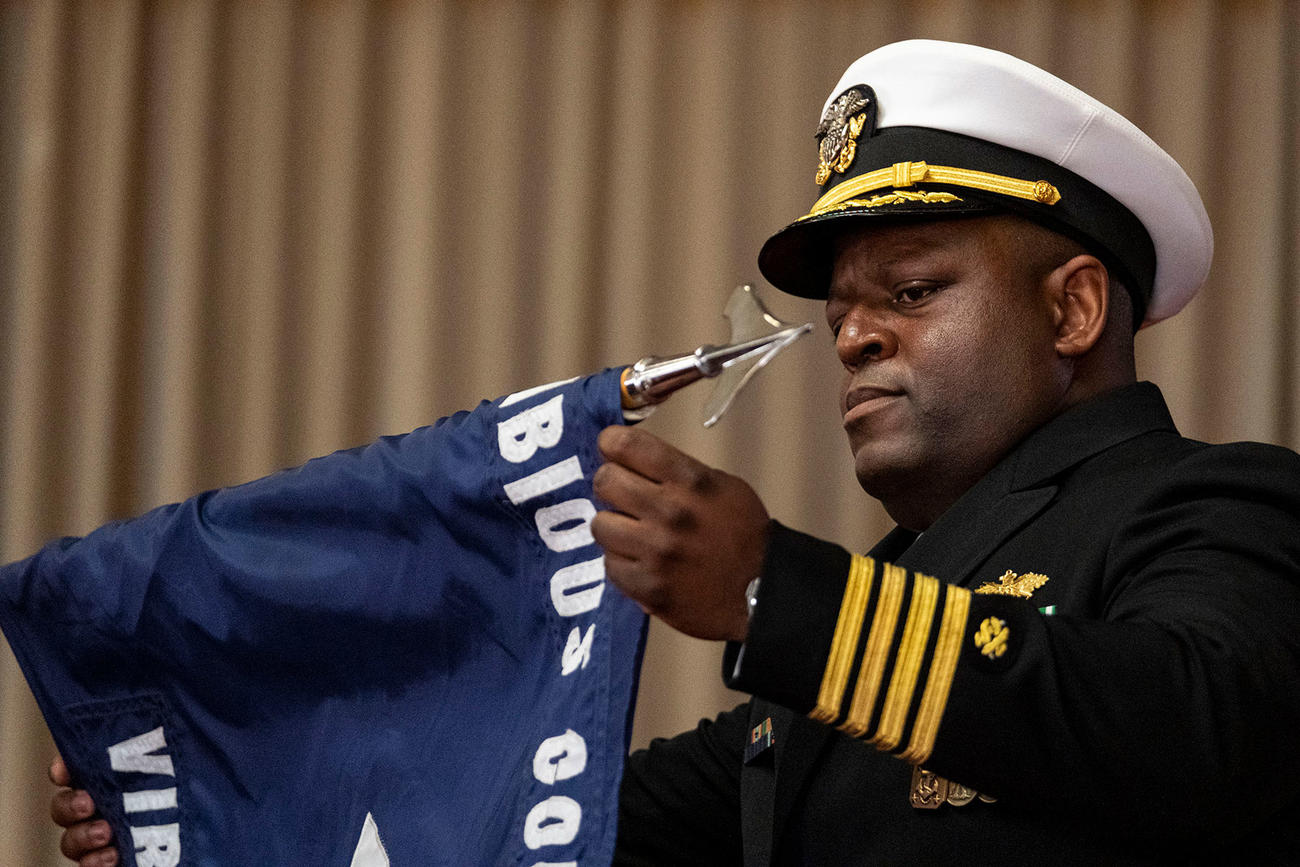
The “Gator Bees” of Amphibious Construction Battalion 2 have embodied the motto of Navy Seabees for nearly 80 years, building and fighting as called upon. But come March 31, the Virginia Beach-based battalion will be deactivated.
Sailors from Amphibious Construction Battalion 2 honored the unit during a decommissioning ceremony Thursday at Joint Expeditionary Base Little Creek’s Chapel.
Amphibious Construction Battalion 2 was one of two unique battalions in the country. It played a major role in maritime prepositioning force operations throughout every conflict in which the U.S. has been engaged since World War II — providing support for ship-to-shore connections and installing numerous military camps.
“All good things come to an end. ACB 2 has accomplishment its mission in its current construct,” said Rear Adm. Dean Vanderley, commander of Naval Facilities Engineering Systems Command and Chief of Civil Engineers.
The Navy decided in July to deactivate the battalion after the elevated causeway system — a modular pier stretching up to 3,000 feet to provide logistic support to Marine Corps and Joint Expeditionary Forces — was removed from the command’s Table of Allowance.
“Therefore, the decision by the Navy to disestablish ACB2 makes sense fiscally as by its closure the Navy loses no unique mission capabilities and sustains a minimal operational impact,” said Lt. Cmdr. Paul Newell, spokesperson for Expeditionary Strike Group 2.
The origins of Amphibious Construction Battalion 2 — formerly known as the 105th Naval Construction Battalion — trace to July 14, 1943, when it was commissioned at Camp Peary in Williamsburg.
Acting as a ship-to-shore link during World War II, Amphibious Construction Battalion 2 established pontoon causeways, barge-mounted cranes and pontoon ferries necessary for amphibious forces to quickly off-load the large quantities of troops and cargo on foreign shores.
The battalion has distinguished itself in myriad operations since World War II, including the 1958 crisis in Lebanon, the Multinational Peacekeeping Force in Lebanon from August 1982 to February 1984, the October 1983 rescue of American citizens in Grenada, Operation Sharp Edge in Liberia in 1991, Operations Desert Shield and Desert Storm in 1992, Operation Uphold Democracy in Haiti in 1994, disaster recovery efforts for TWA Flight 800 and Egypt Air Flight 990 and Operation Iraqi Freedom.
Retired Capt. David Stewart was one of nine former commanding officers in attendance. He and his wife traveled from Stafford to bid farewell. Stewart was assigned the battalion in the 1980s as a junior officer before he returned to lead it in 1999.
Being part of the battalion’s history and its operations, Stewart said, was “an unbelievable, unique opportunity.”
“In the mid-80s, at the time, the battalion’s focus was supporting amphibious operations in the Mediterranean. It was about always being prepared to send teams across the pond,” Stewart said.
As commanding officer from 1999-2001, the immediate mission was very different. Stewart led the battalion when Egypt Air Flight 990 crashed off the coast of New Jersey. His “Gator Bees” were tasked with salvage operations, using tugs to recover the wreckage.
Typically, seabees provide a wide range of construction in support of operating forces, including roads, bridges, bunkers, airfields and logistics bases, and offer responsive support disaster recovery operations. The amphibious seabees are different in that they can be deployed on ships.
“But the world is changing,” Stewart said. “We now project power differently. We now establish our presence differently.”
The battalion was made up of roughly 200 active duty sailors, 650 reservists, and 30 support contractors. But in recent years, active duty sailors assigned to the unit were whittled by two-thirds to about 130.
“This change did not reduce our operational or maintenance requirements. In true Seabee fashion, the command continued to excel. We have continued to success because of the Seabee ‘can do’ spirit and our ability to adapt,” said Capt. Atim D. Senthill, commanding officer of Amphibious Construction Battalion 2.
Since the order to decommission was handed down, the crew has worked to close up shop, with most of the equipment moved to its sister battalion — Amphibious Construction Battalion 1 in San Diego.
This month’s decommissioning marks the third time in its history the battalion has been laid to rest. But it has a history of being recalled in times of need.
“While I am saddened ACB 2 will no longer be on the Navy’s active roster, I know that if this command is ever needed in the future, we will certainly answer the call,” Senthill said.
©2023 The Virginian-Pilot. Visit pilotonline.com. Distributed by Tribune Content Agency, LLC.
Show Full Article
© Copyright 2023 The Virginian-Pilot. All rights reserved. This material may not be published, broadcast, rewritten or redistributed.
Tags: Battalion Building Ceremony Deactivated Decommissioning Fighting Honored Military Navy Navy News Seabee Working Warriors Years








